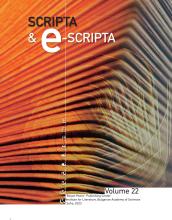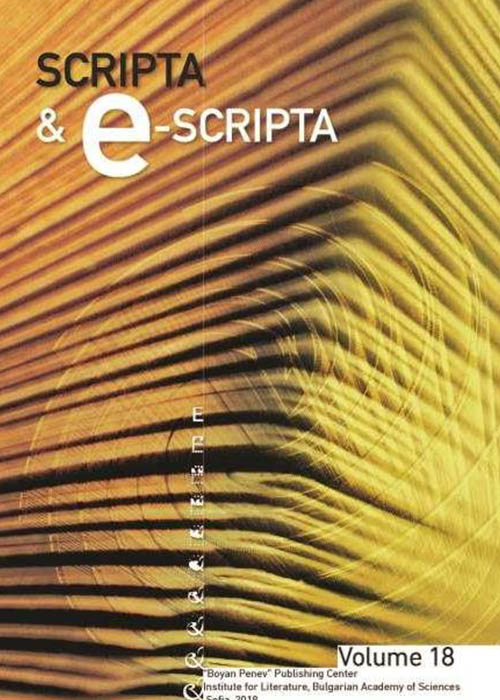The Scene ‘Christ Expels Seven Demons from Mary Magdalene’ in the Post-Byzantine Art
Ралица Русева. Сцената „Христос изгонва седем демона от Мария Магдалена“ в поствизантийското изкуство

- Author(s): Ralitsa Rousseva
- Subject(s): Scripta // Medieval Studies // Linguistic // History of Literature //
-
Published by: Institute for Literature BAS

- Print ISSN: 1312-238X
- Summary/Abstract:
The paper deals with several sixteenth- and seventeenth-century mural representations from different Balkan regions, illustrating Christ Expels Seven Demons from Mary Magdalene as an individual scene. The representations can be grouped in two categories based on the iconographic interpretation of the subject. The first one includes those in the Church of Prophet Elijah (1550) in Sofia and churches associated with the work of St Pimen of Zographou: the Church of the Dormition of the Theotokos in Zervat (1603, Albania), the Church of St Theodore Tyron and St Theodore Stratelates in Dobarsko (1614), the Monastery of St Nicholas in Seslavtsi (1616). The iconography of these four monuments is as a whole very reminiscent of other scenes of healings by Christ. The scene is placed in the context of the Pentecostarion cycle. The second group includes monuments painted by the artists from Linotopi, especially by Nicholas: the Monastery of the Dormition in Spilaio near Grevena (1649); the Monastery of the Transfiguration in Dryovouno (1652) and the Church of St Demetrius in Palatitsion (1570; 17th century). The general iconography here reminds of the healings of demon-possessed, while the iconographic characteristics of Mary Magdalene are akin to those of St Mary of Egypt. The scene is placed among those illustrating the Miracles and Parables.
In the Hermeneias of Dionysios there is no description of the scene, although it is included as a title in Πήγαι in the Divine Works and Miracles of Christ. Probably Dionysios of Fourna was familiar with representations on the subject. For the time being we can only assume that a representation of this scene has existed before 1550, i.e. before it was painted at the Monastery of Iliyantsi.
Journal: Scripta & e-Scripta vol. 22, 2022
-
Page Range: 221-232
No. of Pages: 14
Language: English - LINK CEEOL:
-
Ralitsa RoussevaInstitute of Art Studies, Bulgarian Academy of SciencesDescription
Rousseva, Ralitsa, Assoc. Prof., PhD Institute of Art Studies, Bulgarian Academy of Sciences; Museum for Christian Art at the Crypt of St Alexander Nevski Cathedral, Sofia, Bulgaria
Ralitsa Svetlinova Rousseva is an Associate Professor at the Department of Old and Mediaeval Art in the Institute of Art Studies (Bulgarian Academy of Sciences) and Head of Department „Museum of Christian Art, Crypt of St Alexander Nevsky Cathedral“ (National Gallery). She has over 50 publications on the problematics of Byzantine and Post-Byzantine art. Some of her main topics are the Bulgarian art from 13th–14th century, monuments of Christian art in Albania, iconography of the Slavic saints. In her latest book Golden Book. Icons from Bulgaria (9th–19th century) are analyzed 100 icons, which traces the development of the icon painting in Bulgaria. She is a curator of the exposition in the Museum of Christian Art and the exhibitions: Icônes et manuscrits bulgares, Musées royaux d’Art et d’Histoire, Bruxelles 2002; Bulgarian Christian Art, State Historical Museum, Moscow 2003; curator of the Bulgarian part of the exhibition Byzantium. Faith and Power (1261–1557) at the Metropolitan Museum of Art, New York 2004; The Bulgarian Christian Art 13th–15th Centuries and the Palaeologan Renaissance. National Museum of History, Sofia 2006; Icons from Bulgaria 13th – 19th Centuries. State Historical Museum, Moscow 2009; The Rejoicing of Prayer. Unknown Icons from the Fund of Crypt. Museum of Christian Art, Crypt of St Alexander Nevsky Cathedral”, Sofia 2014 and many others.
-
KEYWORDS: St Mary Magdalene // exorcism // Post-byzantine art // Pimen of Zographou // Linotopi artists // Cretan school // Pentecostarion Cycle // murals //
-